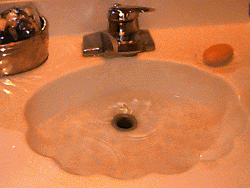


The toilet is wet and moist, with water in and out through pipes and sewers. Sometimes, you have puzzled experience there, especially, in the hand basin, toilet bowl and shower curtain, etc. In this chapter, the hidden science will be revealed and you will have a better understanding on them.
The Swirling of Water in a Basin |
|---|


| How Things Work |
|---|
|
| Insight |
|---|
| Apparently, objects stay on the ground travel the same speed as the ground. As a result, there is no Coriolis effect. For example, a stationary object on the Earth does not exhibit such effect, because the object velocity relative to the Earth is zero. |
The Flush in a Toilet Bowl |
|---|
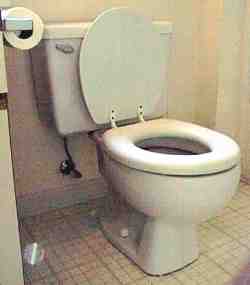 The bowl of a flush toilet is a
porcelain (pottery made of a special white clay) vessel with a built-in siphon, usually visible
(sometimes hidden in some toilet bowls) as a
curved pipe protruding from the back. In most toilets, the bowl has been molded so that
the water released from the tank enters the rim and
it drains out through the holes in the rim. Normally, the bowl contains a small amount of water which is
enough to form an air trap inside the siphon pipe, preventing foul air escaping from the sewer.
The bowl of a flush toilet is a
porcelain (pottery made of a special white clay) vessel with a built-in siphon, usually visible
(sometimes hidden in some toilet bowls) as a
curved pipe protruding from the back. In most toilets, the bowl has been molded so that
the water released from the tank enters the rim and
it drains out through the holes in the rim. Normally, the bowl contains a small amount of water which is
enough to form an air trap inside the siphon pipe, preventing foul air escaping from the sewer.
When the toilet is used, liquid flows slowly through the siphon pipe as waste matter is added, but the flow
volume is too small to fill the siphon. To flush the toilet, the user activates
the water tank which pours a large quantity of water quickly into the bowl. This creates a flow large
enough to fill the siphon pipe, causing the bowl to empty rapidly due to the weight of liquid in the pipe.
The flow stops when the liquid level in the bowl drops below the first bend of the siphon, allowing air to
enter which breaks the column of liquid.
In this section, we are not interested in the refill mechanism in the tank but instead the siphon in the toilet bowl.
The crucial mechanism is called the bowl siphon which is shown in the following animation (Credit: Marshall
Brain's How Stuff Works).

|
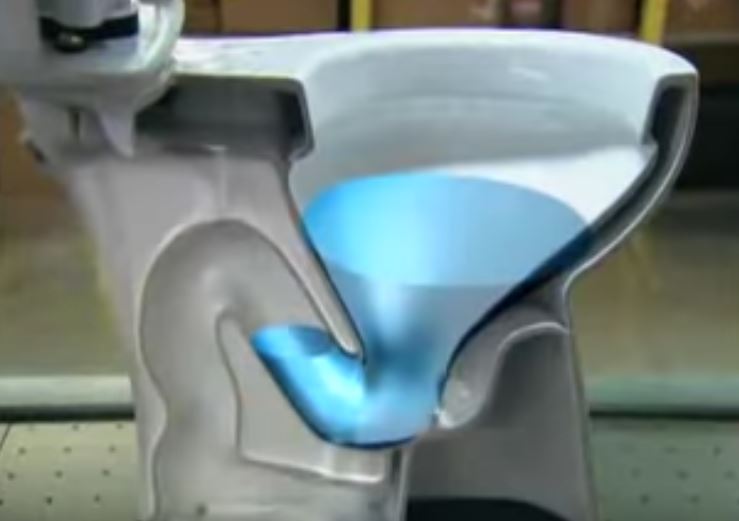
|
| How Things Work | ||
|---|---|---|
The flushing mechanism is summarized in the following points.
| ||
| Science in Depth | ||
|
Shower Curtain |
|---|
 When you are having a shower, the curtain sneak up and slap you on the leg. Do you have
such experience? You might explain it by knowing that the hot air rises.
The hot water in a shower warms the air,
especially the air bounded by the curtain, the cold air then rushes in and
fills the space caused by the escape of hot rising air in the bottom.
The curtain moves inward and slap your leg. Perhaps, it is a reasonable answer. Surely,
you will reject it when you do have the same experience while having a cold shower.
When you are having a shower, the curtain sneak up and slap you on the leg. Do you have
such experience? You might explain it by knowing that the hot air rises.
The hot water in a shower warms the air,
especially the air bounded by the curtain, the cold air then rushes in and
fills the space caused by the escape of hot rising air in the bottom.
The curtain moves inward and slap your leg. Perhaps, it is a reasonable answer. Surely,
you will reject it when you do have the same experience while having a cold shower.
| How Things Work | ||||||||||||||||
|---|---|---|---|---|---|---|---|---|---|---|---|---|---|---|---|---|
There are two possible answers that explain the phenomenon.
| ||||||||||||||||
| Insight | ||||||||||||||||
| ||||||||||||||||
| Science in Depth | ||||||||||||||||
|
Buoyancy |
|---|

| 
| 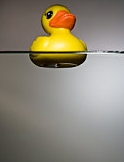
|
| How Things Work | |||||||
|---|---|---|---|---|---|---|---|
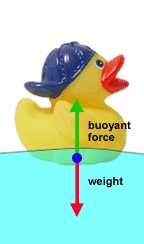 According to the Archimedes' principle, the magnitude of the buoyant force on an object always equals
the weight of the fluid displaced by the object. When you try to push a beach ball down under water. It is extremely
difficult to do because of the large upward force exerted by the water on the ball. The upward force exerted by a
fluid on any immersed object is called a buoyant force. To determine the magnitude of a buoyant force, imagine the
volume occupied by the beach ball is a parcel of water of the same size. This volume of water is at equilibrium and its
weight must be balance by a upward force, i.e. the buoyant force. And, this force is a resultant force due to the
surrounding water. When this parcel is not here and is replaced by the beach ball of the same size, the same buoyant
force applies on this ball.
According to the Archimedes' principle, the magnitude of the buoyant force on an object always equals
the weight of the fluid displaced by the object. When you try to push a beach ball down under water. It is extremely
difficult to do because of the large upward force exerted by the water on the ball. The upward force exerted by a
fluid on any immersed object is called a buoyant force. To determine the magnitude of a buoyant force, imagine the
volume occupied by the beach ball is a parcel of water of the same size. This volume of water is at equilibrium and its
weight must be balance by a upward force, i.e. the buoyant force. And, this force is a resultant force due to the
surrounding water. When this parcel is not here and is replaced by the beach ball of the same size, the same buoyant
force applies on this ball.
| |||||||
| Science in Depth | |||||||
|
Atomizers and Spray Bottles |
|---|
 An atomizer is a device which changes a stream of liquid into a fine spray. It is used in a perfume bottles as well as
inhalers for medications. The working principle is simply the Bernoulli's principle. An atomizer
has several components. A bulb, a nozzle and a tube are connected with each other. There is a vertical tube that allows
the liquid to pass through the nozzle.
An atomizer is a device which changes a stream of liquid into a fine spray. It is used in a perfume bottles as well as
inhalers for medications. The working principle is simply the Bernoulli's principle. An atomizer
has several components. A bulb, a nozzle and a tube are connected with each other. There is a vertical tube that allows
the liquid to pass through the nozzle.
| How Things Work |
|---|
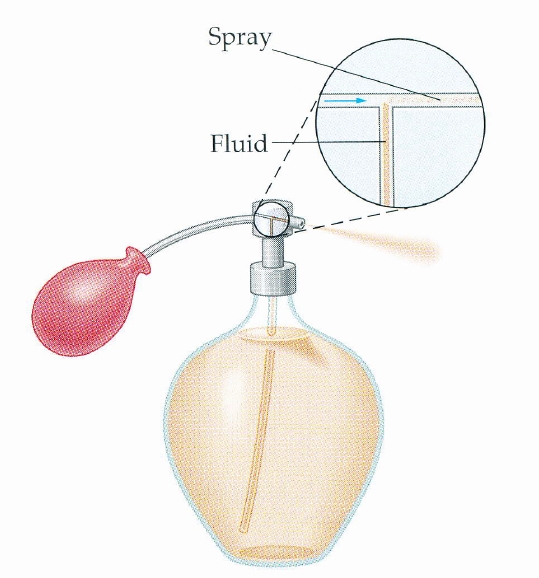
|